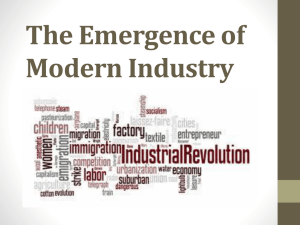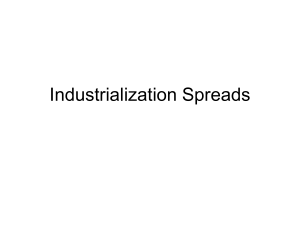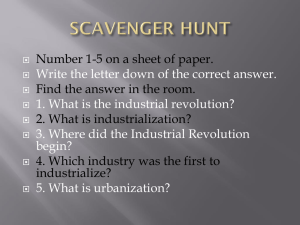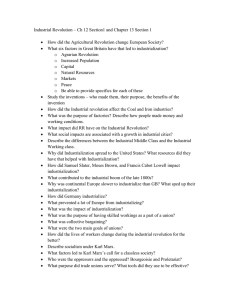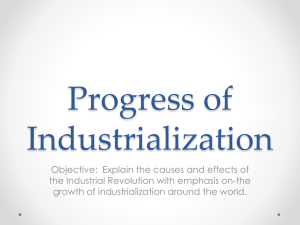Industry - Al Iman School
advertisement
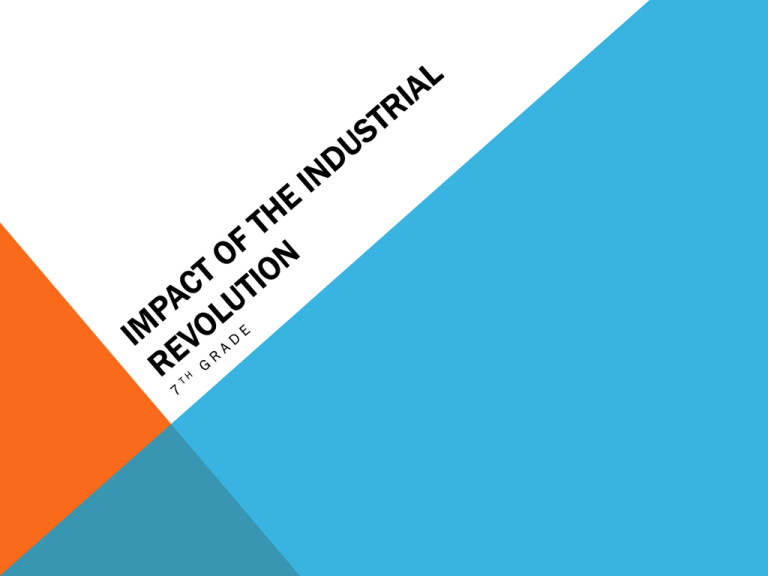
INDUSTRIALIZATION Industrialization brought about many social and economic changes including where people lived as well as how they lived. As a period, industrialization began at different times for different countries all over the world. Migration and immigration increased dramatically as a result of a because of new jobs that became available in the world's developing industrial centers. IMPORTANT PEOPLE… 1. Adam Smith 2. Thomas Malthus 3. Karl Marx 4. Jethro Tull 5. James Watt 6. Edward Jenner 7. Henry Bessemer ADAM SMITH Has been referred to as the father of economics. His book An Inquiry into the Nature and Causes of the Wealth of Nations described various aspects of the market economy. Smith believed in a free market economy, arguing that only free market economies would lead to a productive society. He wanted to see a shift from the older style of mercantilism to a more laissez-faire Laissze-faire (french for "let do") approach in regards to economic activity. WRITE A FEW WORDS…OF WHAT MARKET ECONOMY MEANS WHAT IS LAISSEZ- FAIR…. (KNOW THE DIFFERENCE) THOMAS MALTHUS was an English political economist and demographer studied population growth. He focused on what caused populations to increase faster than the supply of food could be produced. One of his writings, An Essay on the Principle of Population, discussed population growth and its negative effects on society, namely the widespread poverty faced by citizens. KARL MARX 1. A German a. philosopher b. theorist c. sociologist 2. Marx is said to be the father of communism. 3. Marx was a firm believer in a classless society (socialism). 4. His teachings influenced many communist leaders such as Vladimir Lenin and Joseph Stalin of the Soviet Union. 5. The Communist Manifesto, an essential piece of work to the socialist movement, was co-written by another German philosopher, Friedrich Engels. JETHRO TULL 1. was a wealthy farmer who lived in Great Britain and experimented with ways to increase agricultural production. 2. Tull invented the a) seed drill, b) a horse drawn machine that planted seeds one by one in well-spaced rows and at a good depth in the soil. JAMES WATT 1. invented a steam engine in 1769 that produced more power than anything had before. a. Steam allowed factories to be built anywhere, b. when they had previously needed to be built by water sources to use water power. c. Steam was also the source for the greatest transportation inventions of the Industrial Revolution: The railroad locomotive and the steamboat. EDWARD JENNER • A British doctor who developed the world's first successful vaccine. • In 1796, he created a vaccine to prevent smallpox • a disease that was quite deadly during this time period. • Jenner's vaccine was a significant medical breakthrough that saved millions of lives. HENRY BESSEMER 1. Invented a steelmaking process that greatly advanced the steel industry. A. This process, known as the Bessemer Process, made steel by blasting compressed air through molten iron to burn out excess carbon and impurities. INDUSTRIALIZATION IN DIFFERENT NATIONS GREAT BRITAIN 1. Great Britain was the first nation to industrialize. 2. This process began in the 1700s with agricultural reforms and developments in Great Britain's textile industry. 3. The flying shuttle, A. invented by John Kay in 1733, 4. The spinning jenny, a. invented by James Hargreaves in 1764 INDUSTRIALIZATION IN DIFFERENT NATIONS GREAT BRITAIN CONTINUED…. 1. Those were two inventions closely associated with increasing productivity in the textile industry. 2. There were many factors that allowed the British to industrialize before other nations, a. including its stable government and its access to wealth a. Manpower b. Raw materials needed for manufacturing. c. https://www.youtube.com/watch?v=Ib6zTD3nHmg INDUSTRIALIZATION CONT…GREAT BRITAIN 3. This meant Great Britain had an advantage a. Why…..? because it had the resources to fuel industrialization at a time when most other nations did not. 4. Therefore, the Industrial Revolution in Great Britain is normally referred to as the "First Industrial Revolution. INDUSTRIALIZATION IN DIFFERENT NATIONS ….CONTINENTAL EUROPE 1. France and Germany both followed Britain's example and began industrializing in the late 1700s and early 1800s. 2. Industrial growth in France grew slowly in the late 1700s, but the growth was steady into 1800s. 3. Germany, however, grew explosively beginning in the mid-1800s and became the leader of industrialization by the beginning of the 1900s. 4. One of the reasons for this was that Germany's access to the Ruhr Valley and Saar Valley, river areas that were rich with coal and iron resources. 5. Both materials are used in many industrial products, and are particularly important in the production of steel. INDUSTRIAL REVOLUTION UNITED STATES • The United States began to industrialize in the early 1800s. • Due to the establishment of a stable, democratic government, the economy of the U.S. grew explosively during the early to mid-1800s. • Eli Whitney helped this process with the invention of interchangeable parts, • making production easier and cheaper • as people could simply change a single part that needed to be replaced instead of having to repair the entire machine or object INDUSTRIAL REVOLUTION UNITED STATES…. • The United States also shifted from being an agricultural society to an industrial society • This is because increasing industrialization meant that agriculture became more mechanized. • As machines did more of the harvesting • This led to a dramatic increase in urbanization as people left rural areas and flocked to the cities looking for jobs in factories. INDUSTRIAL REVOLUTION IN RUSSIA The term "serf" refers to the status of peasants under the feudal system. Feudalism---- Peasants were held in a type of modified slavery and forced to work farmland for their landowning masters. In 1861, responding to many calls for reform, Tsar Alexander II abolished serfdom. This helped the process of industrialization in Russia as many newly-freed serfs traveled to cities and worked in factories. Russia would not fully industrialize until the twentieth century under the Soviet Union. CAPITALISM AND FREE ENTERPRISE 1. Capitalism describes an economic system in which the means of production are privately owned and operated for profit and free laborers work for wages. 2. Capitalism became the prominent economic system for many countries during the Industrial Revolution CAPITALISM AND FREE ENTERPRISE CONTINUED…. 3. An important aspect of capitalist economies is the idea of a free market. A. A market economy is a system in which prices of goods and services are set by competition and the rules of supply and demand. B. A true free market has very little government regulation of production and distribution. C. Market economies became more important as trade increased. This is because the price of goods was set based on competition in the market. REACTIONS OF CAPITALISM 1. Opposed to capitalism is communism. Communism is a theoretical economic system based on the principles of socialism. Socialism - It can be defined as a system in which the central government plans and controls the economy and a single, often authoritarian, party holds power. The goal -- of this system is progression toward a higher social order in which all goods are equally shared by the people. 2. Utopianism was another response to the social inequalities of capitalism. • How does it relate to Socialism---- Utopian ideas center on making a society in which everyone has equal benefits. SOCIAL DEMOCRACY… Social democracy---People who believe that the government taking an active role in the protection of its citizens. URBANIZATION Urbanization was largely a result of increasing industrialization and can be defined as the development of rural areas into urban areas. As fewer people were needed to work on farms, many flocked to cities to find jobs. Growth in urban centers in countries like England was directly influenced by the industries that were found there. Manchester, England, for example, developed because of its textile industry. FACTORY SYSTEM The factory system is a method of manufacturing that involves bringing workers and machines into one building in order to make the production of goods more efficient. In the domestic system, people worked from home or in small workshops using simple machines and hand tools in order to produce goods. The factory system grew in England in the beginning stages of the Industrial Revolution. RISE OF THE MIDDLE CLASS The developments of the Industrial Revolution also resulted in the growth of the middle class. Middle class occupations included jobs such as the foremen of a factory or office clerks. Life for people in the middle class became better and as they had more money, they also had more time for leisure. Many families found they had more time to take a vacation or visit the beach, a development that was also encouraged by better transportation technologies. The growth of the middle class also coincided with more women being able to stay home. It was considered a sign of status if a family could afford for a wife to stay at home. Poor families, on the other hand, found that they had little to no leisure time and continued to rely on two incomes. WORKING CONDITIONS By the late 1800s, many people worked in factories under terrible conditions. Children from poor families skipped school to work in dangerous factories for very little money. Women and children were both paid significantly less than men. Factories also did not have safety requirements, and many injuries occurred on the job. Those who sustained injuries were left to pay their medical bills without any assistance from their company. Factories forced their employees to work twelve, fourteen, and sixteen hour days or more for at least six days of the week. Some factories employed the sweatshop technique for their workers. In sweatshops, women and children worked long hours, but instead of being paid by the hour, they were paid based on how much work they did. GROWTH OF THE LABOR MOVEMENT These working conditions slowly started to change as labor unions emerged in the late 1800s. In the United States, groups like the Knights of Labor and the American Federation of Labor formed to negotiate better working conditions like higher wages and shorter hours. The American Federation of Labor was formed in 1886, and Samuel Gompers was the president of the organization. Gompers became the leading spokesman during the American labor movement. In many parts of Europe, poor working conditions led to labor movements that attempted to reform their governments. Many reformers began to speak out against capitalism as industrialization spread. These reformers, known as socialists, wanted to end private ownership of businesses and industries in hopes that government-owned businesses would treat workers better. One German philosopher, Karl Marx, asked for workers to unite in revolution to bring down capitalism. POLLUTION Pollution damages the health of people who live in it. During the Industrial Revolution, people who lived in cities were forced to be in environments where the air and water were polluted. Black smog filled the skies of these cities, and water was often not drinkable. This made life even harder for factory workers who worked long weeks and earned little money.
